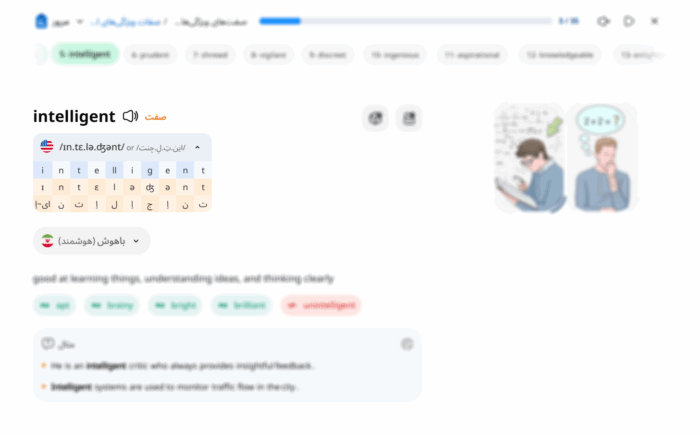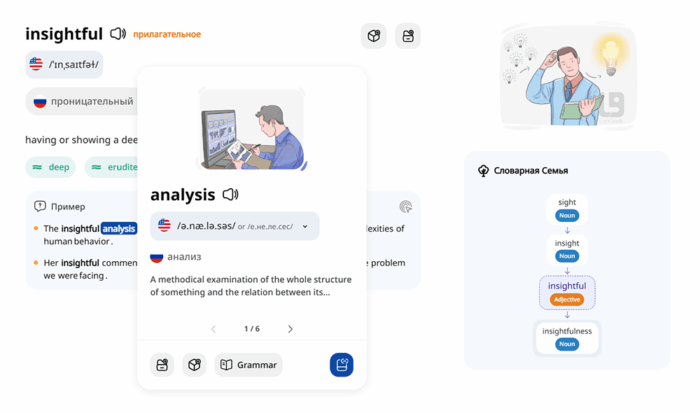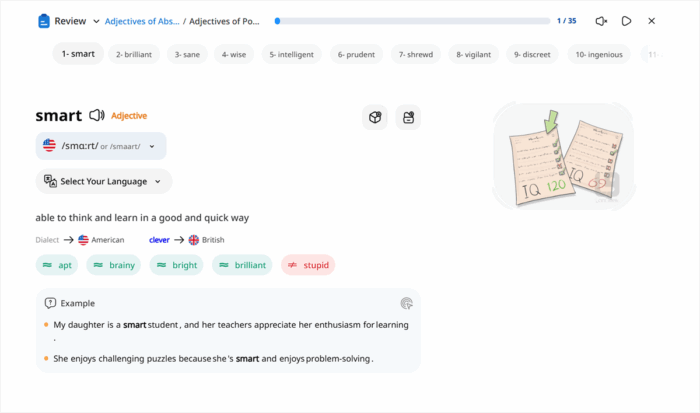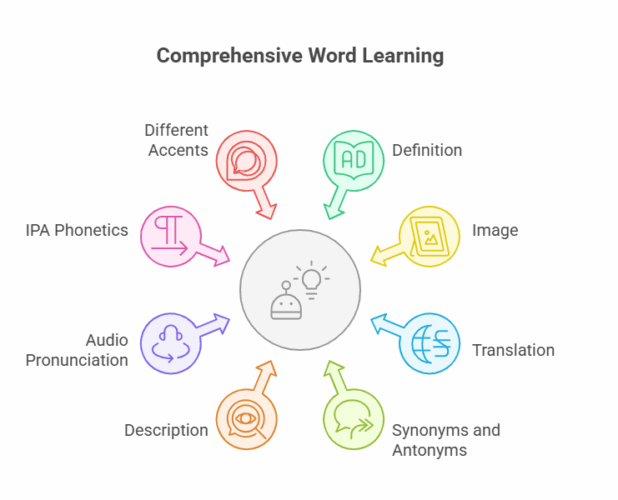The Vocabulary Review section is the foundational step in LanGeek’s four-step vocabulary learning system. It ensures learners gain a complete understanding of each word by focusing on meaning, pronunciation, spelling, and usage. Learning a new word isn’t just about memorizing its definition; it’s about knowing how to use it confidently in real-life situations.
Why Learning New Words Matters
Vocabulary is the cornerstone of language learning. A strong vocabulary boosts all other language skills: reading, writing, speaking, and listening. The more words you know, the better you can communicate, comprehend texts, and express complex ideas effectively.
Key Features of the LanGeek Word Review
1. Meaning and Context
-
Definition: Provides a clear and simple explanation of the word’s meaning.
-
Image: Includes a visual representation to aid in memory retention and understanding.
-
Translation: If the learner has chosen their native language, the word will be translated into that language, making it easier to understand and learn in their own context.
-
Synonyms and Antonyms: Shows words with similar or opposite meanings. This helps learners expand their vocabulary, understand subtle differences between words, and choose the right word depending on the context.
-
Description: A deeper explanation of the concept behind the word, often giving context to its usage.
-
Usage Labels: Labels that show the connotation or context of the word, such as formal, informal, slang, approving, old use, etc., providing insight into when and how the word should be used.
-
Word Family Tree: A small morphological tree that displays words in the same family, helping learners connect related words and understand how they are derived.
How This Helps: The combination of definitions, images, translations, related words, usage labels, and word families helps learners grasp the full meaning of a word from different perspectives, improving retention and application.
2. Pronunciation Mastery
-
Audio Pronunciation: Listen to native speakers pronouncing the word.
-
IPA Phonetics: Learn the accurate pronunciation through the International Phonetic Alphabet (IPA) for each word.
-
Pronunciation Variations: Every word is provided with both American and British pronunciations, helping learners understand and practice the two most common forms of English.
-
Phonomap: Offers phonetic and pronunciation information about the word, including how it is pronounced and whether it is a difficult word to read. It helps learners understand the challenges of pronouncing a word and learn the correct sounds.
 How This Helps: By listening to native pronunciations, referring to IPA guides, and using the Phonomap tool, learners can improve their speaking skills, ensuring clarity and accuracy in their pronunciation. Phonomap’s information also helps learners understand which words might be harder to pronounce, guiding them to pay extra attention.
How This Helps: By listening to native pronunciations, referring to IPA guides, and using the Phonomap tool, learners can improve their speaking skills, ensuring clarity and accuracy in their pronunciation. Phonomap’s information also helps learners understand which words might be harder to pronounce, guiding them to pay extra attention.
3. Spelling Exercise
-
Spelling and Pronunciation Matching: Strengthens the connection between the word’s written form and its spoken sound.
-
Memorizing Irregularities: Focuses on exceptions to typical spelling rules (e.g., irregular verbs).
How This Helps: Correct spelling is critical for effective communication and writing. This feature ensures that learners retain correct spelling alongside pronunciation.
4. Understanding the Word in Context
-
Example Sentences: Provides real-world sentences showing how the word is used. Smart Lookup is active on these sentences, so learners can click on any word in the sentence to instantly view its meaning.
-
Collocations and Grammar Patterns: Illustrates how the word fits naturally into different sentence structures.
How This Helps: Contextual learning helps learners understand how to use words correctly in their own speech and writing, promoting more natural language use. The Smart Lookup feature also makes it easy for learners to explore new words immediately while reading, improving vocabulary comprehension.

5. Grammatical Information
-
Special Grammar Features: Key grammatical aspects of the word, such as whether it’s an irregular verb, an uncountable noun, or an ungradable adjective, are explained in detail.
How This Helps: Understanding a word’s grammatical role ensures that learners can use it correctly in sentences, improving their language accuracy overall.
Integration with Daily Words System & Personal Wordlists
LanGeek employs a Leitner-based spaced repetition system called Daily Words. After reviewing a word, learners can add it to the Daily Words system by clicking on an icon. This system ensures words are reviewed at optimal intervals for long-term retention, making it easier for learners to master vocabulary over time.
The Vocabulary Review section adapts to the wordlist you choose. Whether you’re focused on business, travel, or academic English, you can access relevant vocabulary. Learners can also create and save personal wordlists, which serve as customized collections of words for focused review.
Connecting Word Review to LanGeek’s Learning System
The word review section is just the beginning of a structured four-step process:
- Step 1 – Word Review: Learners acquire full knowledge of the word, including meaning, pronunciation, spelling, and usage.
- Step 2 – Flashcards: A flashcard system helps reinforce word meanings through active recall.
- Step 3 – Spelling Exercise: Learners practice spelling to strengthen retention.
- Step 4 – Quiz: An assessment ensures that learners have mastered the words they studied.
By integrating pronunciation, spelling, usage, grammar, and spaced repetition, LanGeek provides a complete vocabulary learning experience that helps learners reach fluency faster.

Best Practices for Effective Word Learning
Studies have shown that effective vocabulary learning is not just about the quantity of words but also the quality and consistency of review. Here are some research-backed tips to get the most out of your Word Review session on LanGeek:
1. Learn 10-20 New Words per Day, But Review More
While learning 10-20 new words a day is optimal for most learners, it’s equally important to review a larger set of words you’ve previously encountered. This includes words that are in your passive vocabulary—those words you recognize but don’t yet use confidently in speaking or writing. Reinforcing these words through regular review ensures they transition into your active vocabulary.
-
Focus on 10-20 new words to maintain a manageable cognitive load and ensure deep processing.
-
Review more words from previous sessions using spaced repetition systems like Daily Words, flashcards, or other recall techniques to reinforce and activate your passive vocabulary.
This balanced approach of learning new words and reinforcing old ones helps strengthen your vocabulary and ensures the words you know stick with you long-term.
2. Review for 10-15 Minutes Daily
The key to mastering new vocabulary is consistency. Studies on spaced repetition show that spending just 10-15 minutes a day reviewing words leads to significantly better retention. Frequent short review sessions are more effective than longer, less frequent study sessions, as they reinforce memory retention without overwhelming you.
3. Space Your Reviews (Use Spaced Repetition)
The Daily Words system in LanGeek uses a Leitner-based spaced repetition method, which is proven to enhance long-term retention. By reviewing words at optimal intervals—shortly after learning, then gradually spacing out reviews—you ensure that the words stick in your long-term memory.
4. Focus on Active Recall
When reviewing words, aim to actively recall the meaning, pronunciation, spelling, and usage of each word from memory rather than just passively reviewing it. Studies on active recall have shown that the effort of retrieving information strengthens the memory connection and improves learning.
5. Reinforce with Context
Try to use the new words in your own sentences or conversations. Contextualizing words in real-life situations has been shown to improve understanding and recall. The more you practice words in context, the more natural they will feel when you need to use them.
6. Be Consistent
Learning and reviewing words daily is far more effective than cramming large amounts of information in one sitting. Stick to a consistent study routine, and you’ll see steady improvement in your vocabulary and language skills.



